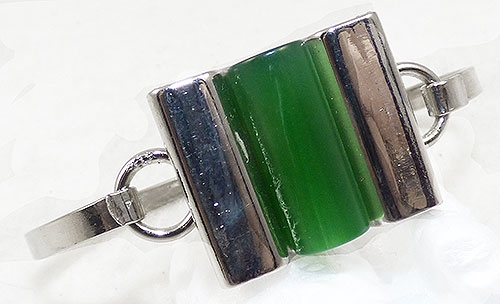Product code: Jakob Bengel Bracelet Machine Age Art online Deco Green Galalith Chrome Sister Clasp
Here we have a Jakob Bengel, link bracelet, created in pyramid-shaped, green galalith stones, in a chrome setting. The style is "Modern Age" and was probably made in the 1930s, during the Art Deco period. It has a sister clasp closure which works perfectly. The bracelet is in very good condition, especially for it's age. It is unsigned, as are most of the Jakob Bengel pieces, but the style and workmanship are definitively his. It's a lovely bracelet that is still fashionable today online. Bracelet measures approximately 7 inches long, by 1/2 inch wide. Please look over the pictures carefully and feel free to message me with any questions. Thanks for looking! The original, Jakob Bengel Chain and Bijouterie Wares Factory was founded, in 1873, in Idar-Oberstein, Germany and initially manufactured watch chains. In 1920, the company began to manufacture costume jewelry and their Art Deco designs became very popular in the 1920s and 30s, in France, where many of their pieces were exporte.
Here we have a Jakob Bengel, link bracelet, created in pyramid-shaped, green galalith stones, in a chrome setting. The style is "Modern Age" and was probably made in the 1930s, during the Art Deco period. It has a sister clasp closure which works perfectly. The bracelet is in very good condition, especially for it's age. It is unsigned, as are most of the Jakob Bengel pieces, but the style and workmanship are definitively his. It's a lovely bracelet that is still fashionable today online. Bracelet measures approximately 7 inches long, by 1/2 inch wide. Please look over the pictures carefully and feel free to message me with any questions. Thanks for looking! The original, Jakob Bengel Chain and Bijouterie Wares Factory was founded, in 1873, in Idar-Oberstein, Germany and initially manufactured watch chains. In 1920, the company began to manufacture costume jewelry and their Art Deco designs became very popular in the 1920s and 30s, in France, where many of their pieces were exporte.




